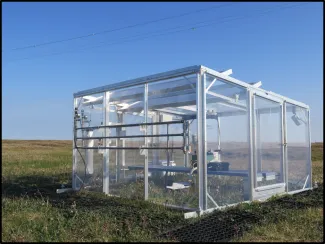Following the successful prototype of a passive warming system, researchers at BNL built and deployed five chambers to investigate thermal acclimation of respiration and photosynthesis. The chamber design is described by Lewin et al. (2017) in a paper that is currently in press at Biogeosciences. Our core goal with the ZPW experiment is to measure key parameters that are inputs for terrestrial biosphere models to enable better representation of CO2 exchange in Arctic vegetation, and to evaluate current model formulations that seek to describe thermal acclimation. Early data suggests marked reductions in leaf respiration and the maximum capacity for CO2 assimilation. At the end of September chambers will be removed and stored for the winter.
For more information, please contact:
Alistair Rogers
arogers@bnl.gov

